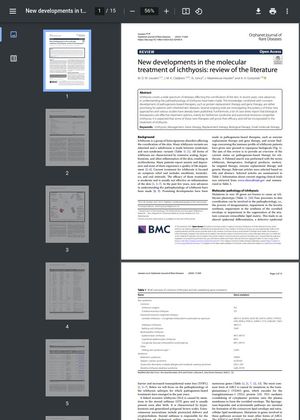New Developments in the Molecular Treatment of Ichthyosis: Review of the Literature
July 2022
in “
Orphanet journal of rare diseases
”
ichthyosis protein replacement gene therapy biological therapeutics immune pathways IL-17 TNF-α secukinumab ixekizumab ustekinumab dupilumab inflammation pruritus scaling enzyme replacement therapy lipid replacement therapy small molecules KLK5 inhibitors preclinical studies gene editing CRISPR/Cas9 X-linked ichthyosis Harlequin ichthyosis randomized controlled trials genetic mutations treatment responses CRISPR

TLDR New treatments for ichthyosis, like protein replacement and gene therapy, show promise and may become standard care.
Recent advancements in the molecular treatment of ichthyosis, a group of genetic skin disorders, show promise through therapies like protein replacement, gene therapy, and biological therapeutics targeting specific immune pathways (e.g., IL-17 and TNF-α). Treatments such as secukinumab, ixekizumab, ustekinumab, and dupilumab have shown potential in reducing inflammation and pruritus, though their effects on scaling are inconsistent. Enzyme and lipid replacement therapies, as well as small molecules like KLK5 inhibitors, have demonstrated potential in preclinical studies. Gene editing techniques like CRISPR/Cas9 and gene therapy for conditions like X-linked and Harlequin ichthyosis are in early clinical stages. Larger randomized controlled trials and studies correlating genetic mutations with treatment responses are necessary to refine these therapies and confirm their efficacy and safety.





